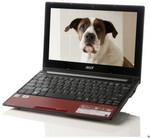Acer Aspire One D255-N55DQws
Specifications

Price comparison
Average of 2 scores (from 3 reviews)
Reviews for the Acer Aspire One D255-N55DQws
Source: Computer Active
 Archive.org version
Archive.org versionThe Acer Aspire One D255 is an update to the D260 netbook we reviewed recently.Acer's rather silly naming convention means there are several D255 models available, with different prices and specifications. A bit more expensive than some netbooks, but this good-looking, relatively powerful model is good value – just make sure you get the right model.
Single Review, online available, Short, Date: 02/18/2011
Rating: Total score: 80%
Source: Techradar
 Archive.org version
Archive.org versionWe like the sentiment and the smartphone-centric OS does transfer nicely on to the netbook – but we can't really see the point and were just as happy using Windows 7 for the above. Fortunately, the Acer Aspire One D255 does the basics very well, making this an incredibly usable and portable option. We're just not convinced about the inclusion of Android, however.
Single Review, online available, Very Short, Date: 02/04/2011
Source: It Pro
 Archive.org version
Archive.org versionThere's little point in buying the Aspire One to use Android which isn't of much use on a netbook for most people. However, when used with Windows 7, the Aspire One is generally a pleasure to use thanks to its long battery life and responsive, comfortable keyboard. If you want extras such as integrated Bluetooth, a SDXC card slot and a matt display, then it may be worth paying £40 more for the Samsung NF210 if you can live with that model's slightly shorter battery life.
Single Review, online available, Very Short, Date: 01/12/2011
Rating: Total score: 83%
Comment
Intel Graphics Media Accelerator (GMA) 3150: Integrated (shared memory) graphics card in the intel Atom N4xx CPUs. Minimally faster than an old GMA 950 and therefore not suited for 3D games or HD videos (only MPEG2 acceleration).
These graphics cards are not suited for Windows 3D games. Office and Internet surfing however is possible.
» Further information can be found in our Comparison of Mobile Graphics Cards and the corresponding Benchmark List.
Intel Atom: The Intel Atom series is a 64-Bit (not every model supports 64bit) microprocessor for cheap and small notebooks (so called netbooks), MIDs, or UMPCs. The speciality of the new architecture is the "in order" execution (instead of the usual and faster "out of order" execution). Therefore, the transistor count of the Atom series is much lower and, thus, cheaper to produce. Furthermore, the power consumption is very low. The performance per Megahertz is therfore worse than the old Pentium 3M (1,2 GHz on par with a 1.6 GHz Atom).
N550: Dual core Atom with a TDP of only 8.5 Watt. Because of the slow clock speed of 1.5 GHz it may be sometimes even slower than a N465 Atom CPU.» Further information can be found in our Comparison of Mobile Processsors.



